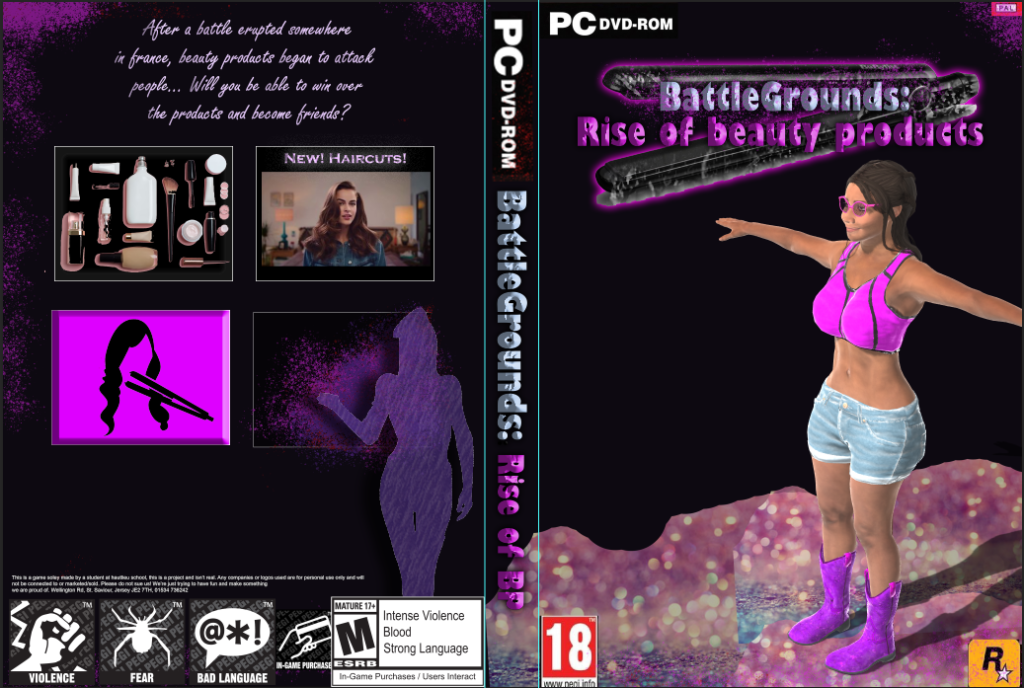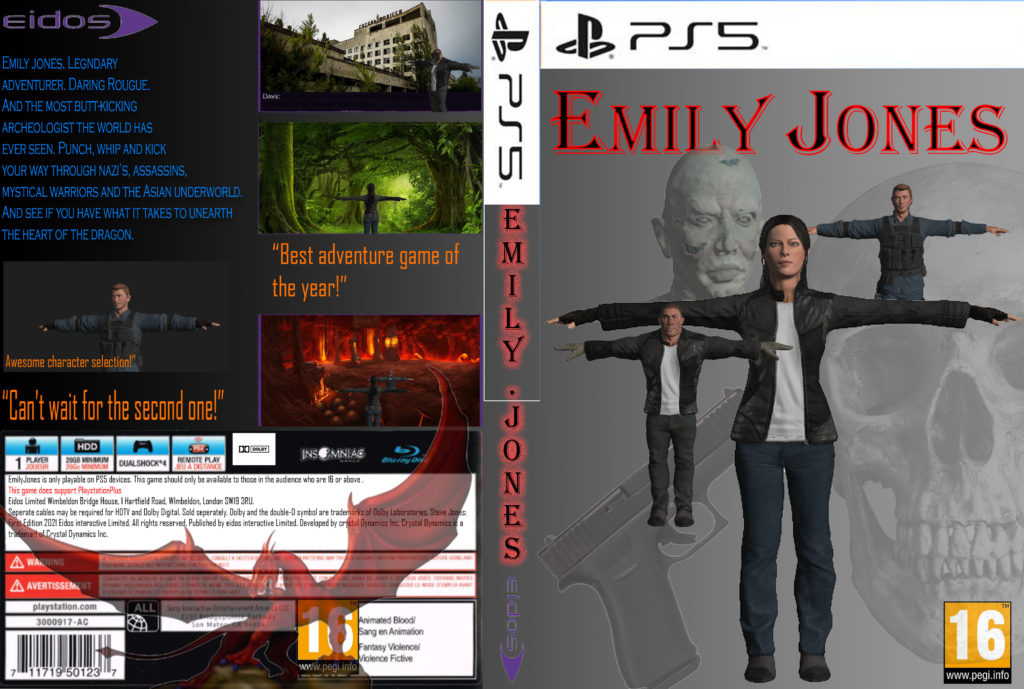
Opposite game cover


ANALYSE THE RELATIONSHIP BETWEEN SIGNIFIERS AND SIGNIFIEDS IN THE TWO CSP GAMES COVERS:
This essay is a semiotic analysis of both the Tomb Raider and Metroid video game covers. I will cover all semiotic language as well as various different media theorists and begin to follow ideas on representation of gender, diversity and the sexualisation of characters in game as well as discussing our patriarchal society and how it is portrayed in our video games. I believe and will argue that depending on gender as well as other factors, it generates a relationship between signifiers that creates a distinct intention and subtle foreshadow to marketing strategies and radical ideologies of women and their representation.
To explain this, when women are used in video game covers, they are usually used in a sexual way that is presumed to be used as a marketing strategy to generate more sales, specifically since that the target market, and the majority of players for video games are males, from pre-teen to adult. In other words, “The presumed straight male” stated by the Feminist Frequency site. Not only this, there is a large stigma regarding women and their capabilities, for example, when we take a look at the Metroid game cover, the dominant signifier is a female fictional character that is represented as strong and powerful, whereas when we look at the game cover of Tomb Raider, we see a female character with little clothing with sexual assets enlarged beyond normality to appeal to voyeuristic attitudes and visions. Although Lara Croft is clearly sexualised there is now a slightly instilled connotation of power in the sense that she is now a symbolic sign of radicalism as she is the main signifier of her own game, and shows some slight progression in generalised view’s of women represented in video games.
Moreover, Metroid is an even clearer sense of this radicalism as she doesn’t show any assets to be enlarged or taken advantage of for marketing, there seems to be less selective representation of her character. However, when Samus (Metroid main signifier) is out of her suit, she is massively over sexualised with a skin tight suit and this constructed reality of voyeuristic ideas being appealed to for the straight male market once more. From this, we see clearly that maybe social structures and dominant ideologies haven’t changed after all. It seems as though we cannot have a female character in video games unless it contains a collective identity across these games where these characters are being sexualised massively. It doesn’t matter if the sexualisation is subtle or obvious, if we want equality for all ethnicity, religion, race, gender as well as other ideas and views we need to create a hegemony where everyone is being fairly interpreted.
I mentioned that the Metroid character is fictional, this is obviously correct, but it still holds a higher connotation and meaning, we constantly see in media that males are held in a higher formality where they are seen to be strong, independent and have an obligation to take care of women. Like mentioned in the feminist frequency website, there is a common use of the “damsel in distress” theme where the female is almost used as an object, just a prize to be won at the end of the game, like commonly seen in the Mario Brothers’ games. This is relevant as although the character is female, its identity is hidden and doesn’t show any signal of feminine characteristics and is almost represented as a male type of character, moreover, to explain this, for a female to be used in video games and their covers, for them to be an appealing strong character for male players, her femininity needs to be hidden and the character needs to be shown as this overly-powerful character. The issue with this is it creates no individuality and doesn’t appose the current social attitudes and structures, it doesn’t create a conversation on how all genders, race and beliefs should be involved in games – making it all the same isn’t the solution.
In conclusion, there is a common misrepresentation of females in video games, but there is also more than that, race and religions all being misused or not being involved at all. But to serve my main point, this use and abuse of the male gaze theory, theorized by Laura Mulvey, clearly shows the minds of the game creators hasn’t changed in recent times and the marketing strategies target voyeuristic attitudes to increase sales.

Answer the following question:
ANALYSE THE RELATIONSHIP BETWEEN SIGNIFIERS AND SIGNIFIEDS IN THE TWO CSP GAMES COVERS (as set out on this post).
This is a A level question from Paper 1 (Media One) 2020 – you can find this paper and the answer booklet by following the link on the top menu of this block. Essentially this is a 500-1000 word Semiotic analysis of two real media products You must try to include ALL of the semiotic media language that you have defined in the previous task.
Use as much of the preparatory written work that you have already completed. Think of it as a ‘cut and paste’ exercise (a bit like your Game covers) where you can construct your essay from the fragments that you have already produced.
In this essay, I am going to apply a semiotic analysis to both the Tomb Raider and Metroid video game covers. I will argue that the over-sexualisation of Lara Croft on the front cover of Tomb Raider is problematic and disrespectful to women. On the other hand, I believe that the front cover of the game Metroid Prime 2 presents its protagonist (Samus Aran) in a fairly progressive manner because her femininity is not overly pronounced in the same way that Lara Croft’s is on the front cover of Tomb Raider.
Looking specifically at Tomb Raider, the main character (and the games dominant signifier), Lara Croft has been designed in a which appeals to the sexual appetite of young, straight, male gamers. This is evident due to a number of factors (an anchorage). Firstly, she has been given a petite frame. Typically, a petite frame naturally has smaller breasts, however, Lara’s breasts have been enhanced (made larger), to make her more sexually appealing. Her skin is golden and smooth, with no cellulite or stretch marks. Her eyes, lips, and nose are all made to look stereotypically attractive, and her face shape is sharp. On the games front cover, her pose is contorted so that both her breasts and bum are visible. And, her clothing is extremely overly sexualised and impractical. Instead of wearing clothes that fit her role in the game she is wearing tight, revealing clothes that emphasise her sexuality and femininity, rather than her power and resilience. She also lacks any bruises or mud on her skin, and her hair isn’t greasy, wet, or out of place despite the fact that she is in damp, stormy conditions for the majority of the day. Also, her body seems to be bizarrely designed given her occupation. Power is a big part of her role in the game, and yet the game developers have chosen to give her a delicate, feminine frame, devoid of any masculine features such as muscles. Physically, she conforms to almost every female body standard, and this is problematic for many reasons. There is already pressure on women to live up to the rigid bodily standards set to them by modern media, which consists of big breasts, clear and hairless skin, curvy yet petite frame, strong jawline with a diamond face shape, long and thick hair, full lips, big rounded eyes, classical makeup, and small nose. Females are also expected to be cautious and carry themselves with a specialised elegance, therefore, they are not expected to have any bruises, scratches, or general imperfections. So, by designing the main female protagonist of a game marketed to malleable teenage boys as perfect (lacking any features which deviate from those aforementioned beauty standards) the game becomes part of the problem regarding the body image crisis. Now, the young men who play Tomb Raider are more likely to question why the (real) women in their lives don’t look like the perfectly crafted Lara Croft.
Continually, I think Laura Mulvey’s ‘Male Gaze Theory’ applies here. Lara Croft seems to have been created by straight men, for straight men. She seems to exist in the game as an object to be looked at, which is deeply wrong. By choosing to present Lara in this way, the game developers of Tomb Raider are essentially reducing Lara’s value as a character to her sexual appeal, rather than her personality and skills as a tomb raider. This sends a rather worrying message to young fans of the game: women exist to be viewed by men.
In addition to this, I question why it is that female protagonist’s in video games have to exude sexuality in order to generate sales. Male characters in video games are frequently shown as powerful, courageous, funny, or goofy. Whereas female characters seem to (for the most part) only be shown in one way… sexualised.
One video game where this isn’t a factor is Metroid Prime 2, which presents its female protagonist (Samus Aran) in a fairly progressive manner. Looking at the index of the front cover. Her big, imposing appearance is stereotypically masculine and portrays dominance. Her armour shows her role in the game. And her gun (a phallic symbol) shows a vital component of her personality (she is violent and dangerous). All of these features deviate from how women are conventionally portrayed in video games, and instead signify that Samus Aran is a male or gender-neutral character. Looking at negatives… there aren’t many, however, It could be argued that the game developers have accentuated her curves to establish her as a female character. But considering that (before I researched the game) I presumed Samus was a male character (for the reasons stated above)… I don’t think this argument holds weight.
Unfortunately, it seems as though the more sexualised women are in video games, the more the game sells. According to Wikipedia, Metroid Prime 2 sold just over 800,000 copies, whereas the Tomb Raider games have sold upwards of 84 million copies. I think it’s interesting to look into why this is. Are young men more likely to buy video games that present their female protagonist in a sexually appealing way? Or do they just buy the best game? I think it depends. But, there is no doubt that there is a systemic problem concerning how women are presented In video games.
Moving my focus back to Tomb Raider, there is one glaring positive concerning its portrayal of women… it avoids using its main female character as a ‘damsel in distress’. In fact, Lara Croft’s storyline is closer to the type of storyline you’d see a masculine protagonist have. She fights and discovers in a similar way to Indiana Jones. For this reason, you could argue that Tomb Raider actually has an overall positive message for young women… but, I’m not convinced. I think the concept of using a female protagonist in a discovery game is a good one, however, the execution just seems off. It feels as though the decision to have a female protagonist was driven more by voyeurism than positive representation, which (to put it lightly) is disappointing.
In conclusion, I feel that the way women are represented in the two games I studied differs fairly drastically. Tomb Raider portrays its female protagonist in a fairly reactionary way, whereas Metroid Prime 2 portrays its main female character radically.












– I changed my dominant signifier, main character from a overly sexualised female whose body was accentuated and exaggerated to a male character with a more ‘realistic’ body type which has some feminine attributes. This character displays a radical representation which goes against the type of character the player would expect to be featured, a counter type
– The male character is wearing baggy clothing and is not particularly attractive, I didn’t want to display his figure or body type or focus on his appearance, rather his purpose in the game. This contrasts to my first design in which the female character wore tight, exposing clothing alongside excessive make up to appeal to the ‘Male Gaze’
– The male character juxtaposes the stereotypical dancer, or character you would picture on the cover of a dance game.
– I changed my colour scheme from a purple and pink scheme to a blue scheme. The blue colour links to the societal stereotype that blue has connotations of masculinity. This also juxtaposes the stereotypical femininity associated with dance in general.